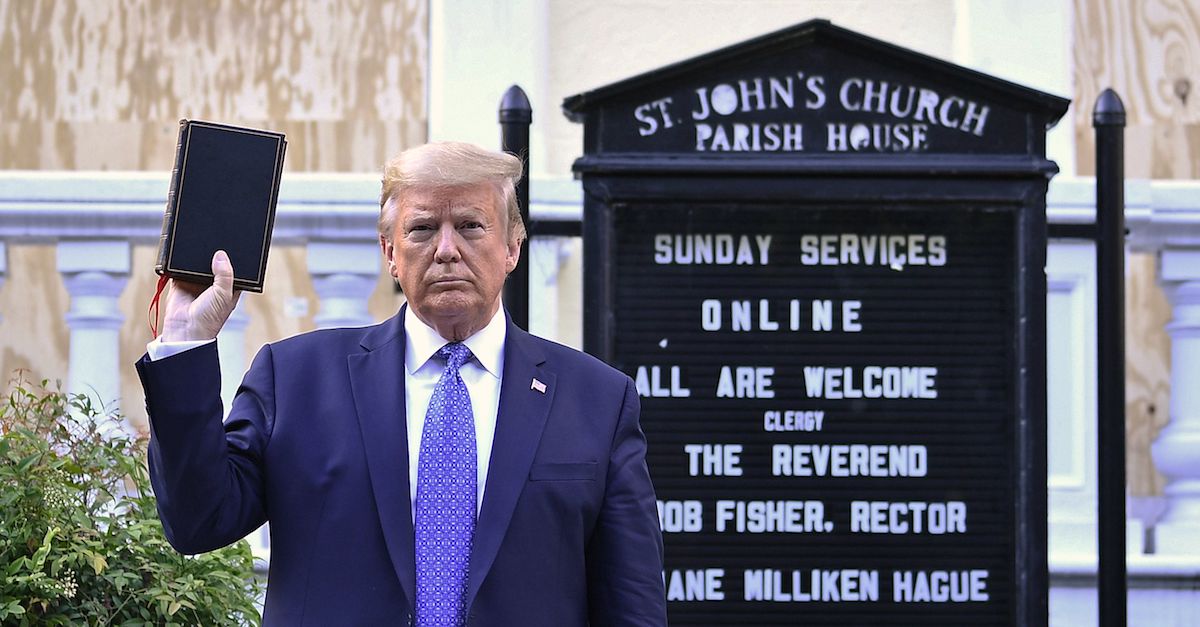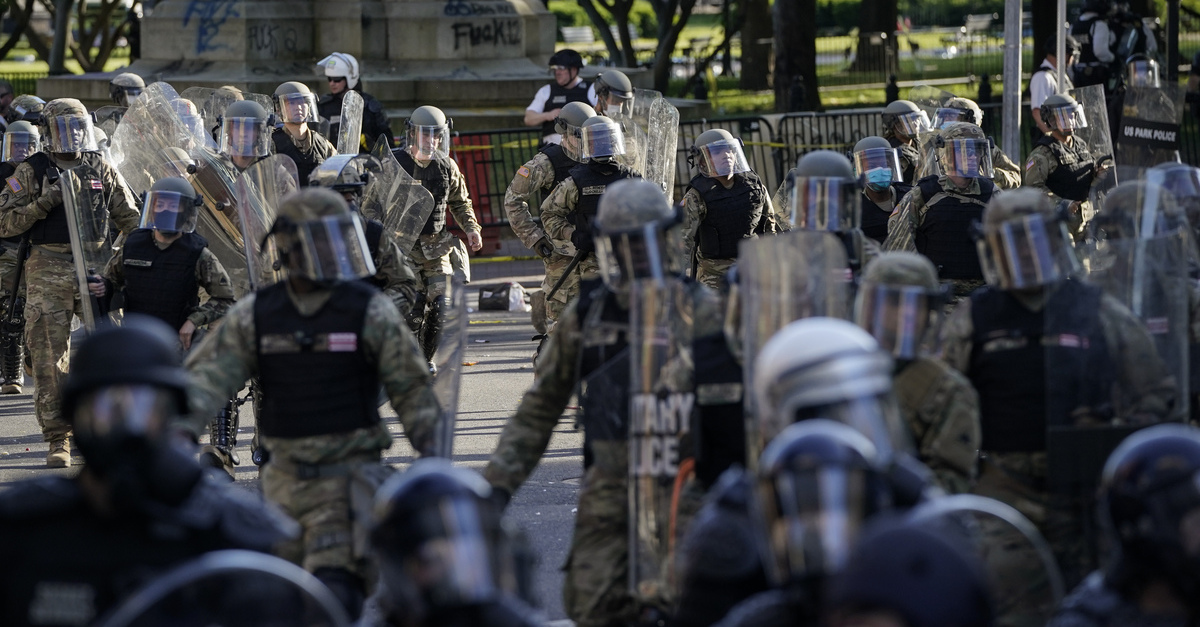
Then-President Donald Trump holds a Bible outside of St John’s Episcopal church across Lafayette Park in Washington, D.C. on June 1, 2020. Trump was due to make a televised address to the nation after days of anti-racism protests against police brutality that erupted into violence. (Photo by Brendan Smialowski/AFP via Getty Images.)
Two federal agencies have agreed to settle a civil lawsuit by protesters and activists who were forced out of Lafayette Square in Washington, D.C. on June 1, 2020, while protesting the death of George Floyd, Jr., the U.S. Department of Justice announced on Wednesday.
The case, styled as Black Lives Matter D.C. v. Trump, ended with a stipulation of dismissal. The document says various federal defendants in their official capacities — “the President of the United States, Attorney General of the United States, Secretary of Defense, Chief of the U.S. Park Police, Director of the U.S. Secret Service, Commanding General of the D.C. National Guard, and Director of the Federal Bureau of Prisons” — agreed to jettison the litigation “with each party bearing its own fees and costs.”
According to a third amended complaint, the named plaintiffs were Black Lives Matter D.C. and Toni Sanders, J.N.C., Kishon McDonald, Garrett Bond, Keara Scallan, Lia Poteet, Dustin Foley, and E.X.F., a series of individual protesters who sued “on behalf of themselves and all others similarly situated.” Two minors, indicated by the aforementioned initials, sued via their parents.
The named defendants were then-president Donald Trump, Attorney General William Barr, Secretary of Defense Mark Esper, Acting U.S. Park Police Chief Gregory T. Monahan, Secret Service Director James M. Murray, D.C. National Guard Director Maj. Gen. William J. Walker, Bureau of Prisons Director Michael Carvajal, Metropolitan Police Chief Peter Newsham, and a collection of Washington, D.C. Metropolitan Police Department officers — some of whom were named, some of whom were identified only by helmet or by arm patch numbers.

Law enforcement responds during a protest near Lafayette Park ahead of President Trump’s trip to St. John’s Church on June 1, 2020 in downtown Washington, D.C. (Photo by Drew Angerer/Getty Images.)
“This case is about the President and Attorney General of the United States ordering the use of violence against peaceful demonstrators who were speaking out against discriminatory police brutality targeted at Black people,” the lawsuit’s opening salvo announced.
The document raised the names of Floyd, Eric Garner, and Breonna Taylor, and it asserted that “a group of demonstrators, including Plaintiffs, gathered peacefully in Lafayette Square to protest the gross, systemic injustices perpetrated by law enforcement against Black people in the United States.”
The lawsuit then went on as follows:
Without provocation, the federal and Arlington County Defendants fired (or ordered to be fired) tear gas, pepper spray capsules, rubber bullets, and flash bangs into the crowd and physically charged at the protestors to shatter the peaceful gathering, forcing demonstrators to flee the area. Demonstrators who fled west away from the Square quickly encountered a formation of Defendant officers of the District of Columbia Metropolitan Police Department, who likewise fired tear gas at demonstrators as they fled. Many peaceful demonstrators were injured, some severely, by this coordinated and unprovoked attack.
Defendants had no legitimate basis to destroy the peaceable gathering. Defendants’ professed purpose—to clear the area to permit the President to walk to a photo opportunity at a nearby church—was a wholly illegal reason for abridging the constitutional rights of Plaintiffs and the others assembled in Lafayette Square. Indeed, the President has consistently demonstrated hostility towards viewpoints different than his own, and in the days and moments leading up to the attack expressed his intent to violently attack protesters and “dominate” them.
It then noted that the DOJ later “officially acknowledged that Defendant Barr ordered Lafayette Square cleared minutes before the assault started.”
“Defendant Barr issued this order following a series of statements from Defendant Trump in the days and hours leading up to this attack in which he clearly threatened to use and encouraged violence against protesters,” the lawsuit alleged.

Law enforcement authorities gathered at Lafayette Square on June 1, 2020. (Photo by Olivier Douliery/AFP via Getty Images.)
The document also alleged various violations of the plaintiffs’ First Amendment rights to speech, assembly, and to petition the government for grievances, violations of the Fourth Amendment right to be free from unreasonable seizures, and several other matters and causes of action (e.g., Bivens actions, 42 U.S.C. § 1985(3) violations; 42 U.S.C. § 1986 matters; and 42 U.S.C. § 1983 issues). Ten counts in total were lodged via the third amended complaint.
The plaintiffs sought a declaratory judgment that the Defendants violated “the First Amendment, the Fourth Amendment, 42 U.S.C. §§ 1983, 1985, and 1986,” injunctions which ordered the individual defendants to “cease engaging in the unlawful acts described herein,” compensatory damages, punitive damages, costs, and attorneys’ fees.
A settlement agreement says — as usual — that the plaintiffs and the defendants agreed to scuttle the matter “without any admission of liability.” It vaguely references “other good and valuable consideration, the receipt and sufficiency of which are hereby acknowledged,” but the paperwork does not directly suggest that money changed hands.
“As part of the settlement,” the DOJ announced in a press release which mirrors the court documents, the Park Police and the Secret Service “agreed to update and clarify their policies governing demonstrations” and to “implement the policy changes within 30 days of today’s settlement.”
“Changes to the agency’s policies include more specific requirements for visible identification of officers, limits on the use of non-lethal force and procedures to facilitate safe crowd dispersal,” the DOJ indicated.
Among the agreed-upon matters is that U.S. Park Police officers will be required “to wear fully visible badges and nameplates including on outerwear, tactical gear and helmets,” the DOJ continued.
The Secret Service, meanwhile, will update its policies “to provide that the fact that some demonstrators have engaged in unlawful conduct does not ordinarily provide blanket grounds for use of force, crowd dispersal or declaration of unlawful assembly,” the DOJ added.
Federal officials reacted positively to the announcement.
“The federal government is committed to the highest standards for protecting civil rights and civil liberties in any federal law enforcement response to public demonstrations,” Associate Attorney General Vanita Gupta said in a statement. “These changes to agency policies for protest responses will strengthen our commitment to protecting and respecting constitutionally protected rights.”
“From the steps of the Lincoln Memorial to the White House sidewalk, the National Park Service takes immense pride in caring for some of our nation’s most storied civic spaces,” said Director Chuck Sams of the National Park Service. “We hope this updated policy can serve as a model for others to uphold civil rights and facilitate safe demonstrations. It is good for the public and good for our officers. The United States Park Police is committed to ensuring people can gather safely to express our most fundamental and cherished right to free speech. This updated policy is designed to be accessible and understandable to both our officers and the public, further strengthening that commitment.”
“We appreciate the Park Police and Secret Service for their efforts to constantly review and revisit their law enforcement policies to evolve and protect those that seek to peacefully exercise their First Amendment rights,” said Matthew M. Graves, U.S. Attorney for the District of Columbia. “These revisions to our law enforcement partners’ policies will further protect those rights.”
In response to an emailed request for comment on Wednesday, Black Lives Matter DC on Friday morning replied to Law&Crime that it “doesn’t have a comment” about the settlement. The organization also refused to acknowledge whether or not any money changed hands as part of the settlement.
The settlement and the full DOJ press release have been merged into one single document below:
[Editor’s note: this piece has been updated to include BLMDC’s declination to comment.]
[images as noted]